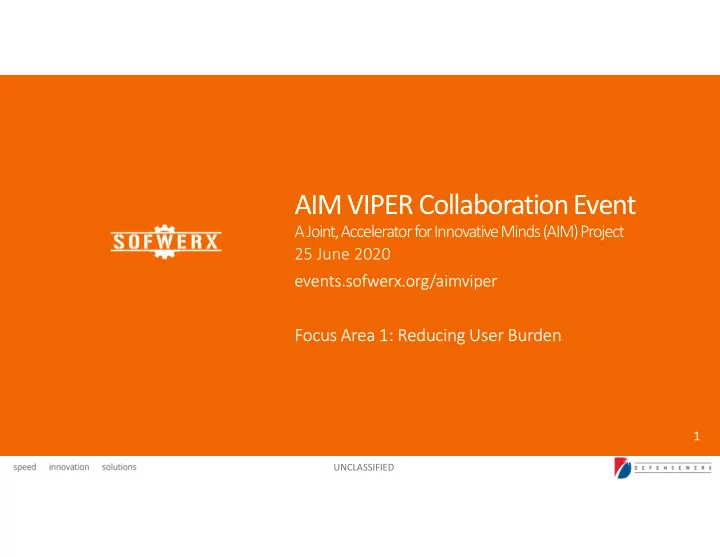

AIM VIPER Collaboration Event A Joint, Accelerator for Innovative Minds (AIM) Project 25 June 2020 events.sofwerx.org/aimviper Focus Area 1: Reducing User Burden 1 UNCLASSIFIED UNCLASSIFIED
Reducing Burden • Measureable progress realized towards advancing protective capabilities in current systems • Breathing difficulties, discomfort, commo problem complaints, etc., persist • Goals for reducing encumbrances often conflict with protection needs or have unintended consequences on user operations (e.g., PAPRs) • Historical mask wear human performance research offers useful, albeit limited, insights on the relationships between design parameters and performance • Most obvious physiological burdens: breathing resistance, visual field of view, discomfort, weight (mass), dead space 2 UNCLASSIFIED
Physiological factors impacting user performance 3 UNCLASSIFIED
Mask design parameters impacting user performance 4 UNCLASSIFIED
Design considerations • Primary vision capabilities related to performance during respirator wear are field of view (FOV) and visual acuity; Field of view is presumed to be most important based upon existing data • Unencumbered field of view (FOV) spans approximately 200 o horizontally by 150 o vertically • Parameters that impact voice communications include speech transmission device designs (e.g., passive or active), location near the mouth, dead volume, and breathing resistances • Additional components such as a protective hood, helmet, and electronic amplification systems will also influence speech sound transmission 5 UNCLASSIFIED
Design considerations • Overall comfort due to the mechanical properties of a respirator includes factors such as mass, facepiece materials/design, suspension materials/design, nose cup materials/design, airflow characteristics (including breathing resistances), and lens design • Subjective comfort various widely among users • Some minimal level of breathing resistance will be present in most respirators • Decrements in performance due to inhalation resistance is linear and there appears to be no defining value at which time performance decreases at a greater rate 6 UNCLASSIFIED
Design considerations • Difficult to focus on one aspect of a respirator system to reduce user burden • Performance = f (V, Com, R, M, Cft) • Impacts on protection must be considered in all designs • Lowering filter resistance would reduce burden but could reduce protection • Challenge is to demonstrate revolutionary concepts 7 UNCLASSIFIED
AIM VIPER Collaboration Event A Joint, Accelerator for Innovative Minds (AIM) Project 25 June 2020 events.sofwerx.org/aimviper Focus Area 2: Interoperability 8 UNCLASSIFIED UNCLASSIFIED
Interoperability • Next Generation Mask should be interoperable with the following SOCOM equipment: • Advanced combat and lightweight helmets Doesn’t inhibit fit or functionality of current helmets. Support rail system use and possibly use existing attachment points to don or doff without removing helmet. • Fielded PAPR, Rebreather, and SCBA systems Reduce burden of multiple masks in user kit. Scalable response using one mask with multiple filter/respirator options. • Works with existing optics Night vision eye relief and pressure on eye lens Vision correction system revamp Weapon optics and cheek stock weld do not become degraded when wearing the mask. 9 UNCLASSIFIED
Interoperability • Communication equipment • Works with fielded communication headsets (Peltor). Form, fit, and function is not reduced when wearing mask and voice output is integrated into mask. • Voice amplification clear and improved over current technology. • Field of view improvements • Integration of networked and non-networked technology into a heads up display • Future CBRN detector information • Air/Gas readings • SCBA PSI • Filter remaining or surety 10 UNCLASSIFIED
AIM VIPER Collaboration Event A Joint, Accelerator for Innovative Minds (AIM) Project 25 June 2020 events.sofwerx.org/aimviper Focus Area 3: Tailored Protection 11 UNCLASSIFIED UNCLASSIFIED
Tailored Protection • The search for the respirator “sweet spot” exists in the level of protection required for the threat, the user mission set, and the user comfort and perception of comfort • Generally, as protection levels increase, the burden on the user increases 12 UNCLASSIFIED
Tailored Protection • Currently issued CB protective equipment is designed for higher levels of contamination at significant durations of use • As such, the default system of use for any threat requiring respiratory protection has a higher burden level associated • Scalability from low to high levels of protection could alleviate this disparity of systems and reduce unnecessary wearer burden when threat does not merit it. 13 UNCLASSIFIED
AIM VIPER Collaboration Event A Joint, Accelerator for Innovative Minds (AIM) Project 25 June 2020 events.sofwerx.org/aimviper Focus Area 4: Face Seal 14 UNCLASSIFIED UNCLASSIFIED
Face Seal • Respirator seal design has been mainly influenced by need for high protection and comfort • Materials have focused on silicones and polyisoprenes for comfort but compromise protection • Butyls provide higher levels of protection but compromise comfort and flexibility • This trade-off represents one of the most significant but is far short of all the considerations • Seals have traditionally focused on sealing along face periphery or along neck (“neck dam”) • Peripheral seals generally follow an “in-turn” periphery design • Neck dams often have comfort complaints due to size variation in necks and criticality of seal • Seal location is critical on neck dam which requires specific donning requirements 15 UNCLASSIFIED
Face Seal • There is a subjective, but widely reported regard for rubber face seals being “too hot, uncomfortable, burdensome, etc…” • Points to the desire for non-traditional sealing methods, materials, mechanics • Yet we must maintain protection of mucous membranes on face 16 UNCLASSIFIED
Recommend
More recommend